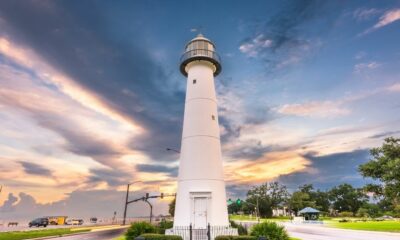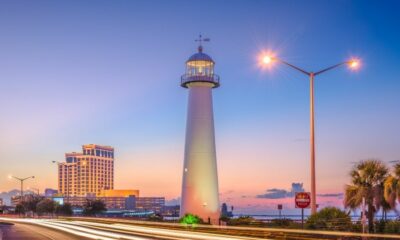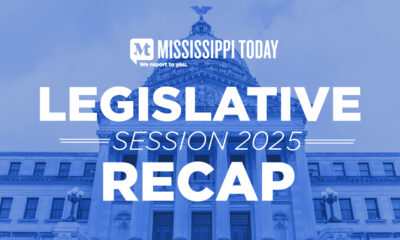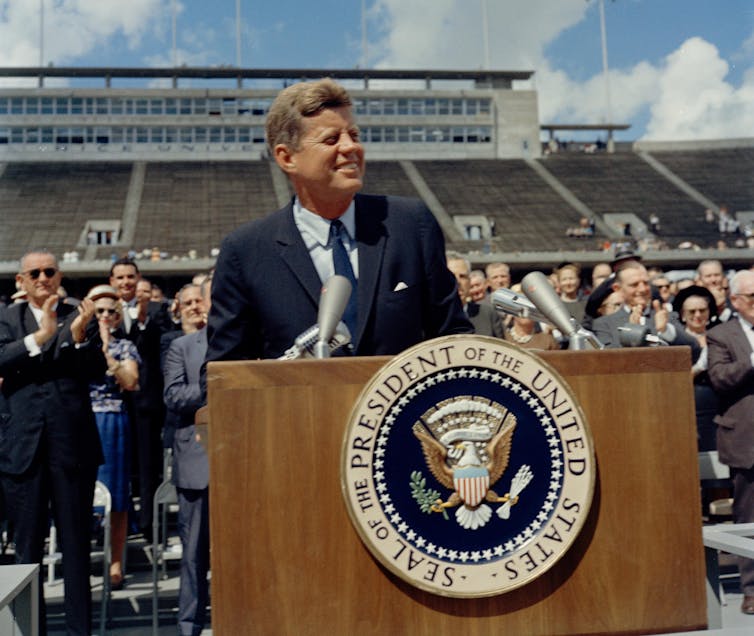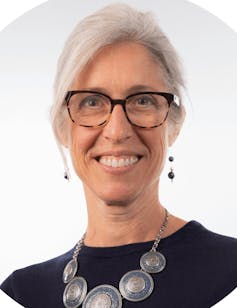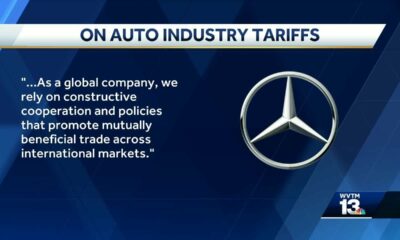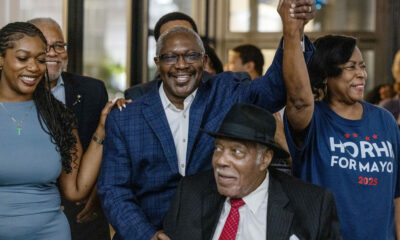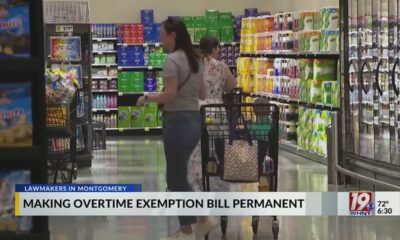
Bryan Bedder/Getty Images for Bloomberg Philanthropies
David Campbell, Binghamton University, State University of New York; Lindsey McDougle, Rutgers University – Newark, and Susan Appe, University at Albany, State University of New York
The 50 American individuals and couples who gave or pledged the most to charity in 2024 committed US$16.2 billion to foundations, universities, hospitals and more. That total was 33% above an inflation-adjusted $12.2 billion in 2023, according to the Chronicle of Philanthropy’s latest annual tally of these donations. Media mogul and former New York City Mayor Mike Bloomberg led the list, followed by Netflix co-founder and chairman Reed Hastings, along with his wife, Patty Quillin. Businessman Michael Dell and his wife, Susan Dell, pledged the third most in 2024.
Neither MacKenzie Scott nor Elon Musk, both of whom announced donations large enough to land them on this list, provided enough information for the Chronicle to include them. Musk didn’t name the nonprofits to which he gave stock, and Scott declined to confirm how much money she put into the donor-advised funds through which she gives. Known as DAFs, these funds are savings accounts reserved for charitable giving.
The Conversation U.S. asked David Campbell, Lindsey McDougle and Susan Appe, three philanthropy scholars, to assess the significance of these gifts and to consider what they indicate about the state of charitable giving in the United States.
What trends stand out overall?
Appe: I think it’s good to see that eBay founder Pierre Omidyar, an Iranian-American entrepreneur born in France, with his wife Pam, are among the top 12 donors. Omidyar is the only foreign-born philanthropist on this list who reported giving to democracy promotion in the U.S. through his Democracy Fund. The Omidyars also funded the AI Collaborative, a group that promotes artificial intelligence governance based on democratic values, and their Omidyar Network, an organization promoting responsible technology.
Given concerns about democratic backsliding around the world, which could arguably include President Donald Trump’s efforts to expand the executive branch’s power, I’m surprised not to see more top donors clearly funding democracy promotion.
I study philanthropy by U.S. immigrants. They either give more or at the same rate as people born in the United States.
Omidyar is one of seven immigrants among 2024’s top U.S. donors. The others are Herta Amir, who was born in what was then Czechoslovakia; Sergey Brin, a Russian immigrant; the Pagidipati family, which came from India; K. Lisa Yang, who was born in Singapore; Michele Kang, who immigrated from South Korea; and Joe Wen, a Taiwanese immigrant.
In 2024, as in most years, many of these wealthy donors supported prestigious universities and large hospitals and stowed millions in their own foundations and donor-advised funds. Although it’s impossible to predict exactly what their foundations and DAFs will support in the future, history suggests that they’re unlikely to focus on addressing systemic issues such as economic inequality.
McDougle: It doesn’t appear that any of these top 50 donors are Black or Latino. This lack of representation is undoubtedly a reflection of broader societal disparities and may influence how individuals from these groups perceive their own potential as philanthropists.
Philanthropic capacity often correlates with wealth accumulation, and significant gaps in wealth between racial groups are likely to have a direct influence on who we see in the Philanthropy 50. Black families, for instance, possess just 15% of the wealth of white families, while Hispanic families have only about 22%. These wealth disparities likely prevent many Black and Latino Americans from having the wealth necessary to engage in large-scale philanthropy.
This reality highlights the need for the nation’s leading philanthropists to fund initiatives that focus on addressing systemic barriers to economic equality. MacKenzie Scott has been doing this through the millions of dollars she has donated to support racial equity and economic mobility.
Addressing these disparities also involves changing the narrative around who is considered a philanthropist. As I have argued before, underrepresented groups may not always see themselves as philanthropists, partly due to limited resources and the historical portrayal of philanthropy as the domain of the wealthy. But by redefining philanthropy to include a broader spectrum of giving, philanthropy can play a pivotal role in leveling the playing field and creating more opportunities for all.
What surprises you about the biggest donors?
Appe: The absence of Oracle co-founder Larry Ellison, Google co-founder Larry Page and former Microsoft CEO Steve Ballmer also stands out due to the presence of many other tech billionaires, including Mark Zuckerberg and Bill Gates, on this list.
Campbell: In addition to Elon Musk, a South African immigrant, not making this list for the second year in a row – even though he is the richest person in the world – Jeff Bezos isn’t listed either. Few private citizens have sought to change American society more than they have – Musk most recently through his role in the so-called Department of Government Efficiency and Bezos through actions he takes as the owner of The Washington Post and the founder of Amazon, among other initiatives.
I believe that it is worth asking why neither of these men, who rank among the wealthiest Americans, made the list this year. While Musk gave too little information to make the list, his previous giving choices raise questions about his commitment to philanthropy as a way to advance the public good. In 2022 and 2023, for example, his foundation gave away less money than required by law and supported organizations that benefit him and his interests, such as schools attended by his children.
Bezos, by contrast, got a lot of attention in 2022 when he announced he would give away his fortune during his lifetime. Yet his giving has come in fits and starts since 2018, when he began to give away billions of dollars to support people experiencing homelessness, preschools for low-income children and efforts to fight climate change.
Do you have concerns about the big gifts these donors provide?
McDougle: The nonprofits receiving these large donations can end up in a precarious situation if that funding suddenly stops. When nonprofits rely too heavily on a few wealthy donors, they may be forced to make abrupt decisions like cutting crucial programs or laying off staff. Obviously, this underscores a core problem with overdependence on these types of major gifts: They can leave nonprofits in a bind and unable to sustain their operations without continued long-term support.
This is particularly problematic if it affects a nonprofit’s ability to engage in long-term planning. As such, when focusing on the giving of the super rich, it is important to consider not just the immediate benefits of their generosity but also the potential instability it can create for the recipients if their gift is not managed strategically.
Campbell: The total given by America’s top donors in 2024 was the sixth-highest in the past decade, after adjusting for inflation. I’d expected to see a larger amount, given that 2024 was the second straight year of stock market gains of 20% or more.
In 2020, when the COVID-19 pandemic began, the top donors gave nearly twice as much to charity as they did this past year; and they gave close to $8 billion more than that in 2021. Why haven’t the wealthiest Americans sustained that level?
Giant gifts to universities, museums and hospitals are surely making a meaningful difference in America and the world. But I wonder why these donors tend not to focus on the challenges facing those who have the least.
One significant exception is the $1 billion Ruth Gottesman gave the Bronx-based Albert Einstein College of Medicine to allow the school to become tuition-free. Gottesman, a former faculty member at the school, chose to honor and support the many first-generation and low-income students trained there. Bloomberg, upping his commitment to ease the tuition burden at Johns Hopkins University, made a similar gift to the medical school at his alma mater and four medical schools at historically black colleges and universities.
To be sure, some of these philanthropists use the foundations they or their relatives control to help meet the basic needs of Americans struggling to get by and address issues such as poverty, disease prevention and criminal justice reform. Melinda French Gates, Warren Buffett, and John and Laura Arnold all directed much of their giving in 2024 to those kinds of foundations.
What do you expect or hope to see in 2025 and beyond?
Appe: The Trump administration has frozen most U.S. foreign aid, endangering the lives of millions of the world’s poorest people. There are calls for the wealthiest philanthropists to help to fill this void. I hope some big donors respond with large gifts to UNICEF, the United Nations agency for children, and the WHO Foundation, which supports the World Health Organization.
Top philanthropists have been slow to react so far. However, the MacArthur Foundation just announced plans to increase its giving over the next two years. MacArthur president John Palfrey said this is a response to what he called a “major crisis” brought on by the Trump administration’s spending cuts. I will observe whether other foundations or some of the wealthiest Americans follow suit.
Still, philanthropy cannot fill all these gaps. The $60 billion in foreign aid cuts represent a sliver of the trillions the Trump administration wants to slice from the federal budget. If it succeeds, donors will have countless other priorities.
Campbell: Events that took place during the first Trump administration, like the murder of George Floyd, the erosion of democratic norms and the separation of immigrant families, led philanthropists to embrace giving that addressed these issues, notably diversity, equity and inclusion initiatives. In the early days of the second Trump administration, prominent donors like Mark Zuckerberg have enthusiastically backtracked on their own DEI policies. I am now watching how other donors position themselves relative to the Trump administration’s objectives – as cheerleaders, combatants or something in between.
The Bill & Melinda Gates Foundation and Arnold Ventures have provided funding for The Conversation U.S. in the past. The Gates foundation currently provides funding for The Conversation internationally.![]()
David Campbell, Professor of Public Administration, Binghamton University, State University of New York; Lindsey McDougle, Associate Professor of Public Affairs and Administration, Rutgers University – Newark, and Susan Appe, Associate Professor of Public Administration and Policy, University at Albany, State University of New York
This article is republished from The Conversation under a Creative Commons license. Read the original article.

